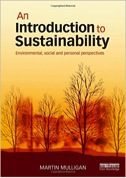Book Review: An Introduction to Sustainability: Environmental, Social and Personal Perspectives by Martin Mulligan
 Anand JSE Nov 2015 Hope Issue PDF
Anand JSE Nov 2015 Hope Issue PDF
Abstract: Martin Mulligan’s An Introduction to Sustainability: Environmental, social and personal perspectives reviews the history of sustainability science, placing emphasis on the social-ecological model. This model introduces the importance of personal values and choices. He discusses topics around four themes: limits to growth, diversity, community and resilience. It is well-written, informative and novel.
Mulligan, M. (2014). An Introduction to Sustainability: Environmental, Social and Personal Perspectives. New York: Routledge. ISBN-13: 978-0415706445
Keywords: sustainability, social ecology model, limits to growth, diversity, community, resilience
Book Review: An Introduction to Sustainability: Environmental, Social and Personal Perspectives by Martin Mulligan
When we choose to participate in today’s world of information exchange, most of us find that not a day goes by without each of us being acutely reminded of the pressures of environmental sustainability. With so much of this information filtered through social media, it is difficult to reflect critically on the issues, even though they may touch us personally or professionally. There are so many experts, so many sources, and while many of us may agree on the problems at large, what still may not be clear is what is at the heart of the problem and how to approach solutions. This is where books like Martin Mulligan’s An Introduction to Sustainability: Environmental, social and personal perspectives become most essential.
The book takes an almost scientific-methodological approach to the subject. It begins with an excellent derivation of the historical context originating in “The Brundtland Report”, but quickly acknowledging the importance of earlier events, such as the publication of Rachel Carson’s Silent Spring. It then moves on to definitions and explaining the methodologies to study sustainability. The last sections of the book are devoted to a few key illustrations of the applications, their successes and failures. In the process, the book focuses around four concepts of sustainability: 1. Limits to growth, 2. Diversity, 3. Community, and 4. Resilience. What is important to point out is that this scientific-methodological approach, highlighting many underlying principles, gives the reader the tools with which to approach any sustainability problem.
Mulligan does the hard work of curating and filtering out the noise from the signal, bringing to the reader the most up-to-date and keystone concepts to help not only educate and raise awareness, but make the reader feel personally involved in the process. In fact, very early on in the book Mulligan makes the distinction that his book goes beyond the classical “triple-bottom line” descriptions of sustainability (environmental, economic, social) and focuses more on the “social ecology” model of sustainability (environmental, social, personal). This is an important distinction that recognizes that transformational change in sustainability science needs to integrate economic aspects more subtly into social life (in this model, “social” refers to economic, cultural and political aspects).
The book is unique and successful in its rigour and ability to integrate across all disciplines. Mulligan gives equal weight to insights from the ecological sciences and to those from the human behavioural sciences. For example, in Chapter 7, entitled “Risk and resilience”, Mulligan presents insights from ecological sources including recent work on “tipping points”, but also discusses “personal resilience”, citing the work of psychologist Michael Rutter.
Part III of the book (Chapters 13-16) present case studies (Water, Food and Agriculture, Urban Development, and Waste). Here, most of the text is devoted to highlighting the multifaceted challenges; however, Mulligan does not suggest very many (if any) success stories or pathways to solution, which could be posited based on the “social-ecology” model. The book is also lacking any concluding remarks. This is where the book could perhaps be improved in subsequent editions.
While the book is clearly written in textbook format, it is far from dry reading. There are many innovative visual and conceptual ways of presenting the information, including very well-thought-out text boxes, timelines presented in the margins, and striking and highly meaningful graphics. The book will be very useful for introductory courses in environmental studies, and also as essential reading for graduate students in interdisciplinary programs who do not have a rigorous background in sustainability science. Indeed, I would consider it an excellent resource for anyone wanting to internalize “sustainability”, its history, definition, relevance to our personal lives and its future applications.










 Madhur Anand is University Research Chair in Sustainability Science at the School of Environmental Sciences, University of Guelph, Canada. She is author/co-author of over 80 peer-reviewed scientific articles, and two books, "Climate Change Biology" (CABI, 2011) and "A New Index for Predicting Catastrophes" (McClelland & Stewart/Penguin Random House Canada, 2015).
Madhur Anand is University Research Chair in Sustainability Science at the School of Environmental Sciences, University of Guelph, Canada. She is author/co-author of over 80 peer-reviewed scientific articles, and two books, "Climate Change Biology" (CABI, 2011) and "A New Index for Predicting Catastrophes" (McClelland & Stewart/Penguin Random House Canada, 2015). 
